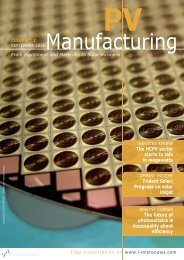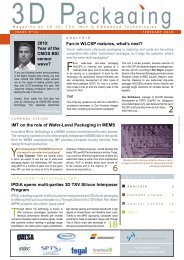3M & SUSS announce agreement on temporary wafer ... - I-Micronews
3M & SUSS announce agreement on temporary wafer ... - I-Micronews
3M & SUSS announce agreement on temporary wafer ... - I-Micronews
Create successful ePaper yourself
Turn your PDF publications into a flip-book with our unique Google optimized e-Paper software.
J U L Y 2 0 0 9 i s s u e n ° 1 1<br />
N e w s l e t t e r o n 3 D I C , T S V , W L P & E m b e d d e d T e c h n o l o g i e s<br />
beginning and much more will be discovered and<br />
understood in up-coming years. The <strong>on</strong>ly thing to<br />
avoid with 3D Integrati<strong>on</strong> is to c<strong>on</strong>tinue thinking<br />
based <strong>on</strong> the past experiences of downscaling.<br />
Applying Moore’s law based <strong>on</strong> scaling to a More<br />
than Moore approach such as 3D Integrati<strong>on</strong> TSV is<br />
not necessary at all. The applicati<strong>on</strong> should help in<br />
the roadmap definiti<strong>on</strong>.<br />
Printed <strong>on</strong> recycled paper<br />
Fig 4 - Applicati<strong>on</strong> Roadmap for 3D integrati<strong>on</strong> in wireless products (Courtesy of ST-Ericss<strong>on</strong>)<br />
wires by c<strong>on</strong>necti<strong>on</strong>s coming from the backside of<br />
the die would gain them a reducti<strong>on</strong> in the camera<br />
volume and its cost. However, in this example, we<br />
can’t speak about TSV enabling 3D c<strong>on</strong>figurati<strong>on</strong><br />
because, in fact, no chips are c<strong>on</strong>nected al<strong>on</strong>g the<br />
vertical axis. The top layer is <strong>on</strong>ly a glass carrier, not<br />
an active die; this can be called 2.5D but definitively<br />
not 3D.<br />
Power Amplifiers (PA) built in SOI are likely to use<br />
TSV technology in the future in order to improve<br />
performance and reduce die size. For PA, TSV is<br />
<strong>on</strong>ly used for parasitic and each is c<strong>on</strong>nected to a<br />
comm<strong>on</strong> ground <strong>on</strong> the metallized backside of the<br />
chip. Wires remain for I/O. In that case, a very low<br />
cost TSV technology is compulsory. Thermal<br />
dissipati<strong>on</strong> improvement is foreseen as well.<br />
The first true 3D ICs using TSV are forecasted for<br />
2012. New partiti<strong>on</strong>ing of chips with IP in the best<br />
techno node will appear. Logic dice would be from<br />
different techno node generati<strong>on</strong>s (N generati<strong>on</strong>,<br />
N+1, N+2…). A smart split of functi<strong>on</strong>s will be d<strong>on</strong>e<br />
in order to achieve the right cost/performance tradeoff<br />
with TSV as the new enabler. An intermediate<br />
step based <strong>on</strong> a silic<strong>on</strong> interposer for the bottom die,<br />
c<strong>on</strong>taining <strong>on</strong>ly routing and few functi<strong>on</strong>s, is likely to<br />
happen. It will help in bridging the gap toward 3D<br />
SoC and a full readiness of design tools. With 3D IC<br />
and TSV, new topics will need to be c<strong>on</strong>sidered.<br />
Numbers of opti<strong>on</strong>s in silic<strong>on</strong> <strong>wafer</strong>s, such as the<br />
type of ESD protecti<strong>on</strong> and test strategy are a few. A<br />
key advantage of 3D IC for this scheme of integrati<strong>on</strong><br />
is clearly the time reducti<strong>on</strong> of critical IP development<br />
in an advanced techno node. With a smart<br />
partiti<strong>on</strong>ing, complexity will be reduced and no<br />
l<strong>on</strong>ger <strong>on</strong> the critical path.<br />
A memory / logic stack using TSV is a type of<br />
applicati<strong>on</strong> the industry often refers to. The main<br />
reas<strong>on</strong> for this is the increased bandwidth required<br />
by the final applicati<strong>on</strong>s (driven by video features<br />
such as 1080p30 playback, 1080p30, 60, 120<br />
Camcorder, 3D gaming…). With a new memory /<br />
logic interface architecture, based for instance <strong>on</strong> a<br />
wide I/O approach, this bandwidth challenge might<br />
be overcome. Furthermore, this new wide I/O<br />
interface with parallel access to the memory will<br />
enable lower power c<strong>on</strong>sumpti<strong>on</strong> in the memory bus.<br />
For cellular ph<strong>on</strong>es, this bandwidth bottleneck might<br />
come after the Low Power DDR2 memory<br />
generati<strong>on</strong>. However, many challenges are rising.<br />
Thermal management is definitively a critical point in<br />
this approach. In effect, the power dissipati<strong>on</strong> of the<br />
logic die, typically an applicati<strong>on</strong> processor or a<br />
digital baseband, can heat the memory directly<br />
stacked <strong>on</strong> top. As memories have a lower Tj than<br />
logic die (85°C or 105°C), the memory will receive<br />
too much heat and w<strong>on</strong>’t work correctly. Power<br />
dissipati<strong>on</strong> of the bottom die will be range from 1 to 3<br />
W from low to high end 3G platforms.<br />
Another main issue with the wide I/O memory is the<br />
standardizati<strong>on</strong> and supply chain. Most of the time,<br />
the memory and logic die will come from different<br />
companies. Standardizati<strong>on</strong> will be required to<br />
enable the final OEM integrator to source different<br />
memory types or any double sourcing.<br />
C<strong>on</strong>clusi<strong>on</strong>s<br />
Roadmaps will mature during the next few years as<br />
people begin to understand all the capabilities of 3D<br />
Integrati<strong>on</strong>. As of today, <strong>on</strong>ly the emerging part of the<br />
iceberg is visible. 3D thinking is <strong>on</strong>ly at its early<br />
It is crucial to differentiate 3D packaging and 3D at<br />
the IC level using TSV. TSV by itself is not a<br />
packaging technology apart from some few<br />
excepti<strong>on</strong>s. C<strong>on</strong>sequently, 3D TSV and 3D<br />
packaging do not have to be c<strong>on</strong>sidered as<br />
competitors but more as complementary areas. In<br />
recent years, the semic<strong>on</strong>ductor industry has<br />
expressed some growing interest in these ideas and<br />
put some significant efforts in allowing the<br />
emergence of these new breakthrough technologies.<br />
Still, some challenges remain ahead for a wide<br />
adopti<strong>on</strong>. Most of them are cost, a shift in the design<br />
method paradigm, system co-design, new CAD<br />
tools, new architectures, and more new challenges.<br />
The 3D IC TSV combined with the 3D eWLB TM<br />
appears as the next wave for future integrati<strong>on</strong> and<br />
should initiate some new integrati<strong>on</strong> schemes. We<br />
expect to expand the innovati<strong>on</strong> landscape through<br />
lower cost and better electrical and thermal<br />
performances enabled by new partiti<strong>on</strong>ing and<br />
architectures, higher flexibility, better integrati<strong>on</strong> with<br />
easier software implementati<strong>on</strong> and a shorter time to<br />
market.<br />
Yann Guillou<br />
New Technology Marketing - ST-Ericss<strong>on</strong><br />
Yann.Guillou@stericss<strong>on</strong>.com<br />
+33 476 58 58 77<br />
Yann Guillou is currently<br />
in charge of New<br />
Technology Marketing<br />
activities for the Wireless<br />
Multimedia Group of ST-<br />
Ericss<strong>on</strong>. His main interest is in 3D Integrati<strong>on</strong><br />
and Advanced Packaging. He started his<br />
career at CEA-LETI before joining<br />
STMicroelectr<strong>on</strong>ics and successively worked<br />
at ST-NXP Wireless and ST-Ericss<strong>on</strong>. He<br />
holds a MSc degree in Materials and<br />
NanoTechnology from INSA (Nati<strong>on</strong>al<br />
Institute of Applied Sciences, France) and a<br />
Specialized Master in Management of<br />
Technology and Innovati<strong>on</strong> from Grenoble<br />
Business School (France).<br />
4
















